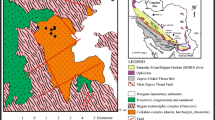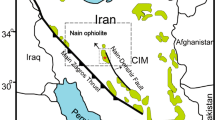Abstract
The podiform chromities occur in a well-preserved mantle sequence consisting of lherzolite-harzburgite with abundant lenses of olivine dunite. The podiform chromitite deposits are common as small and irregularly shaped masses in the Southeastern Desert (SED) of Egypt. The podiform chromities exhibit a wide range of compositions from high Cr to high Al varieties. The Cr of chrome spinel ranges from 0.67 to 0.88 in olivine-dunite, quite similar to that of the high-Cr chromitite, whereas it is around 0.62 in lherzolite-harzburgite. Primary hydrous mineral inclusions, amphibole and phlogopite, in chrome spinel have been reported for the first time from the Pan-African Proterozoic podiform chromitites. On the other hand, petrographic and geochemical evidence suggests that podiform chromitites in the SED of Egypt were formed as a result of crystallization of mafic melts, probably of boninitic composition, the boninitic parental magmas were probably produced by a second stage of melting above a subduction zone. Three types of chromite ores can be distinguished within the SED of Egypt: (a) sulphide-poor podiform ores; (b) brecciated ores; and (c) sulphide-rich ores. Two textural types of inclusions in chromite are distinguished: (1) primary silicate inclusions generally have high Mg-number (>96), Cr and Ni, and are dominated by pargasitic amphibole, forsterite, diopside, enstatite and Na-phlogopite. A diversity of primary and secondary platinum group minerals (PGM) is described from the chromitites, including alloys, sulphides, sulpharsenides and arsenides of Ru, Os, Ir, Rh, Ni, Cu, Fe and Co; (2) in addition to primary PGM and hydrous silicates, the fluids are of low to moderate salinity, sodium-dominated aqueous solutions with complex gas contents. Variable amounts of water, hydrogen, hydrocarbons, carbon dioxides and nitrogen have been determined in inclusion-rich samples. The chondrite-normalized PGE patterns of lherzolite-harzburgite and olivine-dunite have negative Ir and Pt, and positive Pd and Au anomalies. Chromitites are homo-geneous in composition but texturally zoned on a large scale. They carry elevated IPGE, manifested in numerous, primary and secondary PGM phases.
Similar content being viewed by others
References
Amin M.S. (1955) Geology and mineral deposits of Umm Ras Sheet [J]. Geol. Surv. and Min. Res. Dep. Cairo, 78, 70–85.
Arai S. (1992) Petrology of peridotites as a tool of insight into mantle processes: A review [J]. J. JPN Assoc. Mineral Petrol. Econ. Geol. 87, 351–363 (in Japanese with English Astract).
Auge T.H. (1987) Chromite deposits in the northern Oman ophiolite: Mineralogical constraints [J]. Mineral Deposita. 22, 1–10.
Basta E.Z. and Hanafy M.A. (1970) Alteration of some Egyptian chromite [J]. Proc. Egypt Acad. Sci. 23, 1–7.
Biino G.G. and Meisel T. (1994) Major, trace, noble and rare-earth element distribution in polymetamorphic ultramafic rocks (Aar Massif, Central Alps, Switzerland) [J]. Schweiz Mineral Petrogr Mitt. 74, 65–82.
Bonavia F.F., Diella V.K., and Ferrario A.K. (1993) Precambrian podiform chromitites from Kenticha Hill, Southeastern Ethiopia [J]. Econ. Geol. 88, 198–202.
Cassard D.K., Nicolas A.U., Rabinovitch M.H., Moutte J.D., Leblanc M.K., and Prinzhofer A.G. (1981) Structural classification of chromite pods in southern New Caledonia [J]. Econ. Geol. 76, 805–831.
Dick H.J.B. (1974) Terrestrial nickel-iron from the Josephine peridotite, its geologic occurrence, associations and origin [J]. Earth and Planetary Science letters. 24, 291–298.
Dick H.J. and Bullen T.U. (1984) Chromain spinel as a petrogenetic indicator in abyssal and alpine type peridotites and spatially associated lavas [J]. Contributions to Mineralogy and Petrology. 86, 54–76.
Dixon T.H. (1979) The Evolution of Continental Crust in the Late Precambrian Egyptian Shield [D]. pp. 175. Ph. D. Thesis. Univ. California, San Diego.
Dobrozemsky R. (1972) Experience with a computer program for residual gas analyses [J]. Journal of Vacuum Sciences and Technology. 9, 220–233.
Dobrozemsky R. (1990) Calibration of vacuum systems by gas quantities [J]. Vacuum. 41, 2109–2111.
Evstigneeva T. and Tarkian M. (1996) Synthesis of platinum-group minerals under hydrothermal conditions [J]. European Journal of Mineralogy. 8, 549–564.
Ferrario A. and Garuti G. (1990) Platinum-group mineral inclusions in chromitites of the Finero mafic-ultramafic complex (Ivrea-Zone, Italy) [J]. Mineralogy and Petrology. 41, 125–143.
Frost B.R. (1985) On the stability of sulfides, oxides, and native motive metals in serpentinite [J]. Journal of Petrology. 26, 31–63.
Garuti G., Fershtater G., Bea F., Montero P., Pushkarev E., and Zaccarini F. (1997) Platinum-group elements as petrological indicators in maficultramafic complexes of the central and southern Urals: Preliminary results [J]. Tectonphysics. 276, 181–194.
Hassan M.A. and Hashad A.H. (1990) Precambrian of Egypt. In The Geology of Egypt (ed. R. Said) [M]. pp. 201–245. Balkema, Rotterdam.
Harris D.C. and Cabri L.J. (1991) Nomenclature of platinum-group alloys: Review and revision [J]. Canadian Mineralogist. 29, 231–237.
Hilmy M.E., Attia A.K., Boulis S., and Nand Ismail S. (1991) Mineralogy and geochemistry of chromite ores in Abu Dahr and El-Galala areas, Eastern Desert, Egypt [J]. Egypt Mineral. 3, 1–24.
Johan Z.Y., Dunlop H.H., Le Bel L.K., Robert J.L., and Volfinger M.H. (1983) Origin of chromite deposits in ophiolitic complexes: Evidence for a volatile-and sodium-rich reducing fluid phase [J]. Fortschritte der Mineralogir. 61, 105–107.
Kaaden G.V.D. (1964) The different concepts of the genesis of alpine type emplaced ultrabasic rocks. In Methods of Prospection for Chromite (ed. R. Woodtli) [C]. pp. 79–97. Organization Econ. Coop. Devel., Paris.
Khudeir A.A. (1995) Chromain spinel-silicate chemistry in peridotite and orthopyroxenite relicts from ophiolitic serpentinites, Eastern Desert, Egypt [J]. Bull Fac Sci. Assiut Univ. 24, 221–261.
Leblanc M.D. (1991) Platinum-group elements and gold in ophiolitic complexes: Distribution and fractionation from mantle to oceanic floor. In Ophiolite Genesis and Evolution of the Oceanic Lithosphere (eds. T. Peter et al.) [M]. pp. 231–260. Ministry of Petroleum and Minerals, Sultanate of Oman.
Leblanc M.H. (1980) Chromite growth, dissolution and deformation from a morphological point of view: SEM investigations [J]. Mineral Deposita. 15, 201–210.
Leblanc M.L. and Violette J.F. (1983) Distribution of Al-rich and Cr-rich chromite pods in ophiolite peridotites [J]. Economic Geology. 78, 293–301.
Leblanc M.G. and Ceuleneer G.S. (1992) Chromite crystallization in a multicellular magma flow: Evidence from a chromitite dike in the Oman ophiolite [J]. Lithos. 2, 231–257.
Lehmann J.D. (1983) Diffusion between olivine and spinel: Application to geothermomerty [J]. Earth Planet. Sci. Lett. 64, 123–138.
Liipo J.G., Vuollo J.U., Nykanen V.R., Piirainen T.H., Pekkarinen L.H., and Tuokko I.F. (1995) Chromites from the early Proterozoic Outokumpujormua ophiolite belt: A comparison with chromites from Mesozoic ophiolite belt: A comparison with chromites from Mesozoic ophiolites [J]. Lithos. 36, 15–27.
Lorand J.P and Cottin J.Y. (1987) Na-Ti-Zr-H2O-rich mineral inclusions indicating post-cumulus chrome-spinel dissolution and recrystallization in the Western Laouni mafic intrusion, Algeria [J]. Contributions to Mineralogy and Petrology. 86, 251–263.
Lorand J.P. and Ceuleneer G.H. (1989) Silicate and base-metal sulfide inclusions in chromites from the Maqsad area (Oman ophiolite, Gulf of Oman): A model forentrapment [J]. Lithos. 22, 173–190.
Mansour M.S., Bassiouny M.S., and El-Far D.M. (1956) Geology of Umm Salatit-El-Hisinat district [J]. Geo. Surv. and Min. Res. Dep. Cairo. 83, 88–102.
McElduff B.F. and Stumpfl E.F. (1991) The chromite deposits of the Troodos complex, Cyprus: Evidence for the role of a fluid phase accompanying chromite formation [J]. Mineral Deposita. 26, 307–318.
McElduff B. and Stumpfl E.F. (1990) Platinum-group minerals from the Troodos Ophiolite, Cyprus [J]. Mineralogy and Petrology. 24, 211–232.
Naldrett A.J. and Duke J.M. (1980) Pt metals in magmatic sulfide ores: The occurrence of these metals is discussed in relation to the formation and importance of these pres [J]. Science. 208, 1417–1484.
Naldrett A.J., Hoffman E.L., Green A.H., Chou C.L., and Naldrett S.R. (1979) The composition of Ni-sulfide ores, with particular reference to their content of PGE and Au [J]. Can Mineral. 17, 403–415.
Osman A. F., Mohamed F. H., and Amin B.M. (2001) Progressive serpentinization of some ultramafics in Semail Ophiolite, Mundassah Range, United Arab Emirates. M.E.R.C. Ain Shams Univ. [J]. Earth Science. 15, 32–48.
Pederson R.B., Johannesen G.M., and Boyd R. (1993) Stratiform platinum-group element mineralizations in the ultramafic cumulates of the Leka Ophiolite Complex, Central Norway [J]. Econ. Geol. 88, 782–780.
Prichard H.M., Ixer R.A., Lord R.A., Maynard J.N., and Williams N.H. (1994) Assemblages of platinum-group minerals and sulfides in silicate lithologies and chromite-rich rocks within the Shetland ophiolite [J]. Canadian Mineralogist. 32, 271–294.
Prichard H.M., Neary C.R., and Potts P.J. (1986) Platinum-group minerals in the Shetland ophiolite. In Metallogeny of Basic and Ultrabasic Rocks (eds. M.P. Gallagher et al.) [C]. pp. 395–414. The Institution of Mining and Metallurgy, London.
Roberts S.R. (1988) Ophioitic chromitite formation: A marginal basin phenomenon [J]. Economic Geology. 83, 1034–1036.
Saleh E.A and Ibrahim M.E. (1998) Geology and geochemistry of a chromite occurrence at W. Biam-W. Murra area, South Eastern Desert, Egypt. M.E.R.C. Ain Shams Univ. [J]. Earth Sci. Ser. 12, 219–229.
Shepherd T.J. (1981) Temperature-programmable, heating-freezing stage for microthermometric analysis of fluid inclusions [J]. Economic Geology. 76, 1244–1247.
Stevens R.E. (1944) Composition of same chromites of the Western Hemisphere [J]. Am. Min. 29, 1–34.
Talkington R.W. and Watkinson D.H. (1986) Whole rock platinum-group element trends in chromite-rich rocks in ophiolitic and stratiform igneous complexes. In Metllogeny of Basic and Ultrabasic Rocks (eds. M.P. Gallagher et al.) [C]. pp. 427–440. The Institution of Mining and Metallurgy, London.
Thayer T.P. (1966) Serpentinization considered as a constant volume metasomatic process [J]. American Mineralogist. 51, 685–710.
Thayer T.P. (1969) Gravity differentiation and magmatic reemplacement of podiform chromite deposits [J]. Economic Geology. 4, 132–146.
Thayer T.P. (1970) Chormite segregations as petrogenetic indicators [J]. Geol. Soc. South Africa, Spec. Pub. 1, 380–390.
Thayer T.P. and Lipin B.R. (1978) A geological analysis of world chromite production to the year 2000 A.D.: A.I.M.E. [J]. Econ. Council, Ann. Mtg. Proc. 107, 143–152.
Torres-Ruiz J.C., Garuti G.K., Gazzotti M.F., Gervilla F., and Hach-Ali P.F. (1996) Platinum-group minerals in chromities from the Ojen lherzolite massif (Serrania de Ronda, Betic Cordillera, Spain) [J]. Mineralogy and Petrology. 56, 25–50.
Zhou M.F., Robinson P.T., and Bai W.J. (1994) Formation of podiform chromities by melt/rock interaction in the upper mantle [J]. Mineralium Deposita. 27, 192–199.
Zhou M.F., Robinson P.T., and Bai W.J. (1996) Formation of podiform chromite deposits by the melt/rock interaction in the upper mantle [J]. Mineralium Deposita. 29, 98–101.
Zhou M.F. and Robinson P.T. (1997) Origin and tectonic environment of podiform chromite deposits [J]. Econ Geol. 92, 259–262.
Author information
Authors and Affiliations
Corresponding author
Rights and permissions
About this article
Cite this article
Saleh, G.M. The chromite deposits associated with ophiolite complexes, Southeastern Desert, Egypt: Petrological and geochemical characteristics and mineralization. Chin. J. of Geochem. 25, 307–317 (2006). https://doi.org/10.1007/s11631-006-0307-5
Issue Date:
DOI: https://doi.org/10.1007/s11631-006-0307-5




